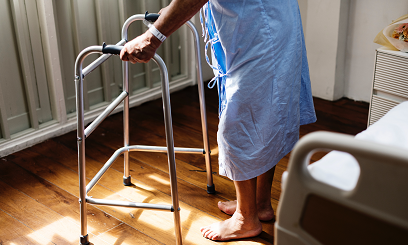Untreated osteoporosis in residential aged care facilities
Putting older people at risk
New Macquarie University research has found that osteoporosis is an under recognised disease for people living in residential aged care facilities leading to a higher risk of life threatening injury.
- Osteoporosis is a common disease effecting more than one million Australians. While osteoporosis can be prevented, once diagnosed, it should be treated with medication, exercise and diet to prevent hip fractures that often prove life-threatening.
- Osteoporosis reduces bone density and puts people at greater risk of fracture: An estimated 866 out of 100,000 women with osteoporosis will have a hip or femur fracture in a given year if their osteoporosis is untreated.
- Underreporting of osteoporosis prevents osteoporosis from being prioritised and treated: 34% of people living in Australian residential aged care facilities are diagnosed with osteoporosis but the number should be much higher.
- The Royal Commission into Aged Care Quality and Safety has pointed to underperforming medication management as a leading concern.
- Macquarie University researchers are calling for better recognition of osteoporosis for people living in aged care facilities.
The first large study of osteoporosis medication use among people living in Australian residential aged care facilities has shown there may be significant under reporting of osteoporosis in electronic health records.
Internationally, research shows that around 85% of people living in residential aged care have osteoporosis, however the figure recorded in a large sample of Australian facilities as part of research by the Australian Institute of Health Innovation, Macquarie University, released today in the journal of Health Services Insights is much lower.
The study of over 10,000 residents from 68 residential aged care facilities in New South Wales and the ACT showed that one third had osteoporosis recorded in their health records.
Lead author, Dr Kim Lind, Research Fellow, Australian Institute of Health Innovation, says: “We believe that the lower than expected number of people with reported osteoporosis in NSW and ACT aged care facilities is due to under-reporting in the health record, rather than lower rates of disease.”
Just as the Royal Commission into Aged Care Quality and Safety has pointed to underperforming medication management as a leading concern, Dr Lind states that osteoporosis diagnosis and management is a prime example of where systematic monitoring of adherence to medication guidelines could quickly improve the care of our most vulnerable people.
Dr Lind commented “We predict that the actual number of people in aged care facilities with osteoporosis is much higher and those missing out on a diagnosis are not being treated for what could lead to a serious life-threatening injury.”
Researchers surmise that people in residential aged care facilities have so many other chronic health issues such as dementia, diabetes or heart disease, that their osteoporosis is not recognised or prioritised and therefore not treated, thus it is not reported on their health record.
Results from the study suggest that many people may not be receiving the PBS subsidised medication that would reduce their risk of fracture.
Even a minor bump for an older person with osteoporosis may result in a fracture as osteoporosis reduces the density of bones, weakening them significantly. Dr Lind says:
Hip fractures can be particularly devastating, changing an older person’s life forever
After a hip fracture, the risk of death in the following year increases and most older people have significant declines in their health and ability to carry out everyday tasks. This decline in health and functioning often leads to a loss of independence.
Dr Lind urges people to act to firstly prevent osteoporosis occurring through regular weight bearing exercise and including calcium and vitamin D in their diet. Once osteoporosis has occurred however, medication can be used to reduce the risk of fracture.
“Appropriate use of osteoporosis medication reduces the loss of bone density thereby protecting people from the chance of fracture as they age”, says Dr Lind.
Researchers urge aged care facilities to give greater attention to identifying osteoporosis among residents and offering treatment options.
END
Journal article citation: Lind, K. E., Jorgensen, M. L., Gray, L. C., Georgiou, A., & Westbrook, J. I. (2019). Anti-osteoporosis Medication Use in a High Fracture-Risk Population: Contemporary Trends in Australian Residential Aged Care Facilities. Health Services Insights. https://doi.org/10.1177/1178632919852111
Acknowledgement: Funding was provided by an Australian Research Council Linkage Grant (LP120200814).
CENTRES RELATED TO THIS NEWS
Centre for Health Systems and Safety Research
FOR FURTHER INFORMATION, PLEASE CONTACT
Chrissy Clay, Research Outreach Coordinator
